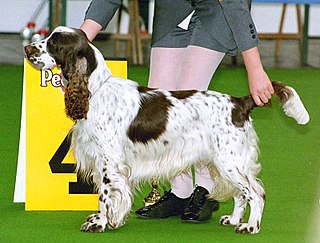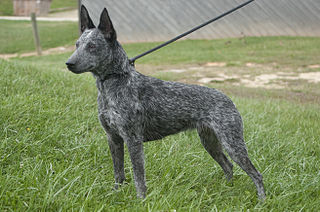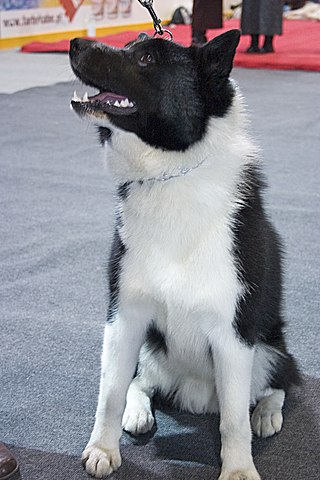
The Sloughi, or Arabian Greyhound, is an ancient breed of domesticated dog, specifically a member of the sighthound family. It originates from North Africa and is found in Algeria, Tunisia, Morocco and Libya.

The Akita is a Japanese dog breed of large size. Originating from the mountains of northern Japan, the Akita has a short double coat similar to that of many other northern spitz breeds. Historically, they were used by matagi for guarding and the hunting of bears.

The Kuvasz is a Hungarian breed of flock guardian dog. Mention of the breed can be found in old Hungarian texts. They have historically been royal guard dogs, or guarded livestock, but have been increasingly found in homes as pets over the last seventy years. The American Kennel Club includes the breed in the working dog group.

A dog breed is a particular type of dog that was purposefully bred by humans to perform specific tasks, such as herding, hunting, and guarding. Dogs are the most variable mammal on Earth, with artificial selection producing upward of 360 globally recognized breeds. These breeds possess distinct traits related to morphology, which include body size and shape, tail phenotype, fur type, etc, but are only one species of dog. Their behavioral traits include guarding, herding, and hunting, and personality traits such as hyper-social behavior, boldness, and aggression. Most breeds were derived from small numbers of founders within the last 200 years. As a result of their adaptability to many environments and breedability for human needs, today dogs are the most abundant carnivore species and are dispersed around the world.

The American Kennel Club (AKC) is a registry of purebred dog pedigrees in the United States. In addition to maintaining its pedigree registry, this kennel club also promotes and sanctions events for purebred dogs, including the Westminster Kennel Club Dog Show, an annual event which predates the official forming of the AKC, the National Dog Show and the AKC National Championship. The AKC is a non-member partner with the Fédération Cynologique Internationale. The AKC recognizes 200 dog breeds, as of 2022.

The Vizsla, also known as Hungarian Vizsla, Magyar Vizsla or Hungarian Pointer, is a dog breed from Hungary and belongs to the Fédération Cynologique Internationale (FCI) group 7, the Canadian Kennel Club (CKC) group 1, and the American Kennel Club. The Hungarian or Magyar Vizsla or Smooth-Haired Vizsla are sporting dogs and loyal companions. The Vizsla's medium size is one of the breed's most appealing characteristics. As a hunter of fowl and upland game, the Vizsla has held a prominent position among sporting dogs – that of household companion and family dog.

The Barbet is a medium-sized breed of French water dog. It is a rare breed. The breed's name comes from the French word barbe, meaning 'beard'.

The Fédération Cynologique Internationale is the largest international federation of national kennel clubs and purebred registries. The FCI is based in Thuin, Belgium and has 98 members and contract partners.

A dog show is an animal show, an event where dogs are exhibited. A conformation show, also referred to as a breed show, is a kind of dog show in which a judge, familiar with a specific dog breed, evaluates individual purebred dogs for how well the dogs conform to the established breed type for their breed, as described in a breed's individual breed standard.

The St. Bernard or Saint Bernard is a breed of very large working dog from the Western Alps in Italy and Switzerland. They were originally bred for rescue work by the hospice of the Great St Bernard Pass on the Italian-Swiss border. The hospice, built by and named after the Alpine monk Saint Bernard of Menthon, acquired its first dogs between 1660 and 1670. The breed has become famous through tales of Alpine rescues, as well as for its large size and gentle temperament.

A kennel club is an organization for canine affairs that concerns itself with the breeding, showing and promotion of more than one breed of dog. Kennel clubs became popular in the mid 19th century. All-encompassing kennel clubs are also referred to as 'all-breed clubs', although "all" means only those breeds that they have decided to recognize, and "breed" means purebred dogs, not including dog hybrids and crossbreeds or mixed-breed dogs. A club that handles only one breed is known as a breed club.

The Olde English Bulldogge is an American dog breed, recognized by the United Kennel Club (UKC) in January 2014. The breed is listed in the UKC Guardian Dog Group. Five years prior to UKC recognition, the breed was registered by the former Canine Developmental, Health and Performance Registry (CDHPR), a privately held business located in Kalamazoo, Michigan. In the early 2000s, CDHPR had been working with the UKC under a unique agreement to develop breeding plans and strategies in an effort to produce improved breeds of dogs that would be accepted as purebred and, therefore, eligible for UKC registration.

The Araneta Coliseum, also currently known by naming rights sponsorship as Smart Araneta Coliseum, is an indoor multi-purpose sports arena that is part of the Araneta City in the Cubao area of Quezon City, Philippines. Nicknamed "the Big Dome", it is one of the largest indoor arenas in Asia, and one of the largest clear span domes in the world. The dome measures approximately 108.0 meters (354.3 ft) making it the largest dome in Asia from its opening in 1960 until 2001 when it was surpassed by the Ōita Stadium in Japan with a dome measuring 274.0 meters (899.0 ft).

The Australian Stumpy Tail Cattle Dog, commonly known as the Stumpy, is a naturally bobtailed or tailless medium-sized cattle dog closely related to the Australian Cattle Dog. The Australian Stumpy Tail Cattle Dog and the Australian Cattle Dog share Halls Heeler origin.

The CzechoslovakianWolfdog is a breed of wolfdog that began as an experiment conducted in Czechoslovakia in 1955. The breed was known as Czech Wolfdog until 1982.

The Moscow watchdog is a guard dog developed in the former Soviet Union, now Russia. It descends from crosses between the St. Bernard, the Caucasian Shepherd Dog and the Russian Pinto Hound. It contains the physical size, attractiveness and intelligence of a St. Bernard and the awareness and assertive traits of a Caucasian Shepherd Dog.

Askal, also called aspin, refers to the diverse population of mongrel free-ranging dogs found in the Philippines.
Temperament tests assess dogs for certain behaviors or suitability for dog sports or adoption from an animal shelter by observing the animal for unwanted or potentially dangerous behavioral traits, such as aggressiveness towards other dogs or humans, shyness, or extreme fear.

Russo-European Laika is the name of a breed of hunting dog that originated in the forested region of northern Europe and Russia, one of several breeds developed from landrace Laika dogs of Spitz type. The Russo-European Laika itself dates to a breeding program begun in 1944 by E. I. Shereshevsky of the All-Union Research Institute for the Hunting Industry, in Kalinin Province.

Svenska Kennelklubben is a Swedish organization dedicated to purebred dogs, and dog owners. It was formed on 13 December 1889 by a group of noblemen and hunters with the aim to maintain the capability of good hunting dogs. According to its charter, the goals of the organization are "to create interest in, and promote, the breeding of mentally and physically healthy purebred dogs that are adequate in terms of working and hunting and that have a favorable appearance".



















